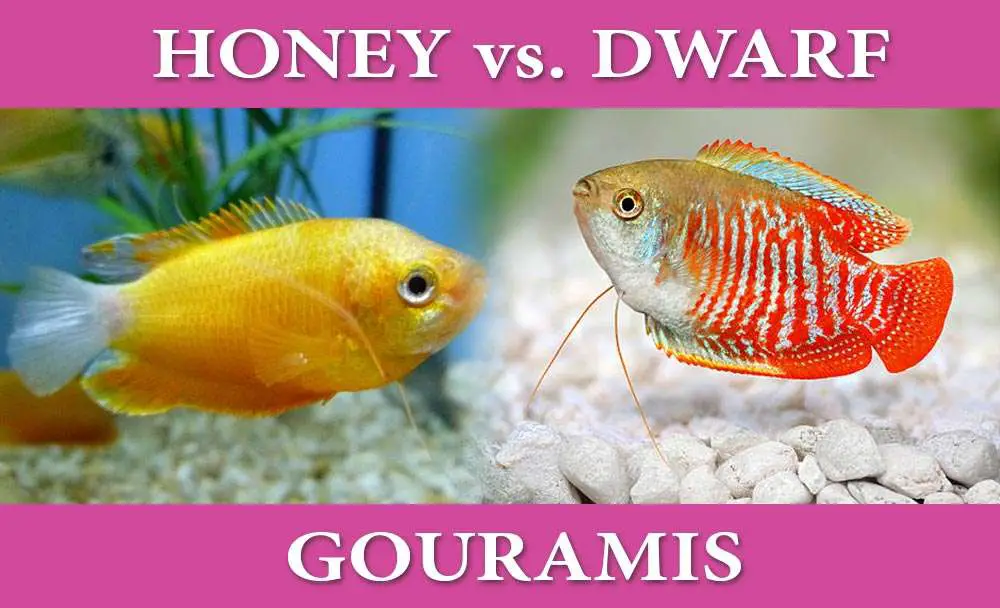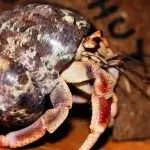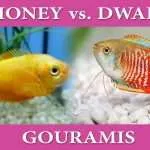Are you interested in choosing between Honey and Dwarf Gourami, but unsure due to incomplete or conflicting information on Honey vs. Dwarf Gourami debates?
This blog post will explain everything you need to know.
Honey and Dwarf Gourami are freshwater Anabantoidei (Labyrinth Fishes) and belong to the Belontiinae subfamily. They possess an additional respiratory organ that enables them to survive inside the tank with low oxygen.
They can come to the top of the aquarium to breathe oxygen.
The possession of this respiratory organ, called Labyrinth, which enables them to survive in shallow, oxygen-deficient water or ponds, is what distinguishes them from other fishes.
Honey vs. Dwarf Gourami Compared
| Honey Gourami | Dwarf Gourami | |
|---|---|---|
| Temperament: | These are peaceful and active fish that works well in the community. They get easily intimidated. When faced with a more territorial fish in the tank, they always run into hiding among leaves. | Dwarf Gourami is an aggressive fish that love to be alone. He quarrels with other gouramies or fish in the tank whenever he is not alone. |
| Color: | They are bright, bold, and very peaceful. Honey Gouramies are only available in two colors: Yellow and Orange. | People fall in love with this specie because it is available in different colors and always looks beautiful in the tank anytime they swim around. You will see them in Blue/ Opal, Red, or pale blue. |
| Size: | They grow up to 2 inches. | They grow up to 3- 3.5 inces. |
| Tank size: | Honey Gourami requires between five and ten gallons of tanks. | I won't recommend keeping Dwarf Gourami in tanks less than 20 gallons. They love doing their things and need to be able to move around without interacting with other fishes. |
Let us examine and compare Honey Gourami and Dwarf Gourami in more detail:
Honey vs. Dwarf Gourami: The Origin
The Honey Gouramis (Trichogaster chuna) are originally from Assam in northeast India and Bangladesh. These areas are susceptible to flooding.
They are adaptable to the drastic change in water chemistry in their original habitat, which constantly experiences flooding.
As a way of adapting to their origin, the Gouramis can tolerate abuse because they can survive in varying water values, food, and temperature.

However, keeping their aquarium in a warm area is essential.
They require a heavily planted aquarium with many bottoms and a good cover of floating plants.
A sponge filter is required in the tank to simulate the type of their original habitat, which is slow-moving water.
Male vs. Female Honey Gouramies
Both male and female Honey Gouramies look the same.
The male is usually yellowish or orange, except during spawning.
During spawning, the color of the male turns from a shade of honey to ocher, the color of the throat changes to blue, and a touch of black or smokey quartz gray on the front section of the anal fin.
The female Honey Gourami is generally brown.
While the Honey Gouramies are generally cowardly and peaceful, they are territorial during spawning.
Honey Gourami Diets
They are omnivores. They feed on small live foods like Insect larvae, crustaceans, and other invertebrates.
You can give your Honey Gourami general fish foods like flakes, vegetables, and tablets.
Breeding Honey Gourami
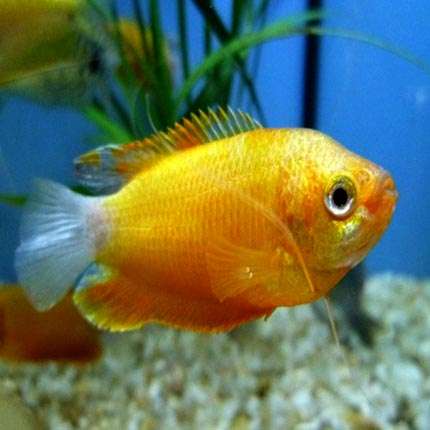
The Honey Gouramis are very easy to breed.
During spawning, the male builds a bubble nest. The male would court the female till she dropped some eggs, and the male would carry the eggs in its mouth into the nest.
The pair would defend their territory during spawning and usually occupy around 80 sq. in. or (500 sq. cm.)
Tank Requirement:
As I stated, they require a heavily planted aquarium with many floating plants.
Water hardness up to 15 degrees dGH and pH between 6.0 – 7.5
Honey Gourami Tank Mates
Combining Honey Gourami with smaller, peaceful, and calm species is best.
Examples of Tank mates for honey Gourami are:
- Cardinal Tetra
- White tip Tetra
- Bristlenose pleco
- Guppies
- Corydoras catfish
Dwarf Gourami
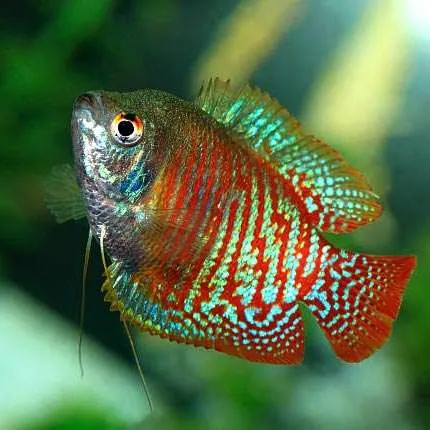
Dwarf Gourami (Trichogaster lalius) comes in various highly vibrant colors, and unlike the Honey Gouramis, they can grow up to 3.5 inches in length.
The Dwarf Gouramis are among the most popular Gourami species.
Origin:
Dwarf Gourami’s origin is in the slow-moving waters of the Northeastern part of South Asia, around India’s Wetlands of the Granges and Yamuna Rivers.
Moreover, they are also found in Brahmaputra Rivers that flow through Tibet, India, and Bangladesh.
Temperament:
Although they are small-sized fish, they have some unique personalities. They are peaceful and timed like the honey Gouramis.
However, keeping two male Dwarf Gouramis together in the same tank is not advisable unless you have a huge tank.
Care level for Honey and Dwarf Gourami
Both Honey and Dwarf Gourami are not beginner’s fish. They are for more experienced and advanced Aquarists.
Honey vs. Dwarf Gourami: The similarity
Dwarf Gourami shares the same type of diet as Honey Gourami.
The Dwarf Gourami, like the Honey Gourami, builds bubble nests during spawning and are both territorial.
In both species, the male always guides the eggs during spawning.
They hatch their eggs between 24 and 36 hours.
Remove both male and female from the tank between 2-3 days after hatching. Otherwise, they would eat the fry.
Honey vs. Dwarf Gourami: Maintenance Procedures
They both require the same water conditions.
Tank temperature for both Honey and Dwarf Gourami is between 72-82 degrees F (22-28 degrees Celsius)
Honey and Dwarf Gourami require a tank minimum of 15.5 inches (40 cm) long and 10 gallons tank.
Moreover, a more extended tank is better than a deeper tank because they both need ample tank space to move around.
Male vs. Female Dwarf Gourami
How do you determine the sex of your Dwarf Gourami?
The male Dwarf Gourami is smaller and thinner. The female has a rounded belly.
Moreover, the dorsal fins are the main differences between male and female Dwarf Gouramis.
The dorsal fins in the females are short and rounded, while it is longer and pointy in the males.
Tank Mates for Dwarf Gourami:
Both Honey and Dwarf Gourami require the same type of smaller and peaceful tank mates.
Here are some other fishes that can share the tank with the Dwarf Gourami:
- Chili Rasboras
- Zebra Danios
- Neon Tetra
- Cardinal Tetra
- Mollies
- Harlequin Rasboras
- Otoclinus Catfish
Final Words
Honey vs. Dwarf Gourami: Which is better?
Unfortunately, they are more or less the same.
They are from the same family, with only slight species variation in the area of sizes and colors.

